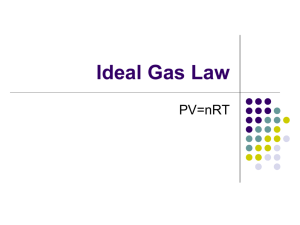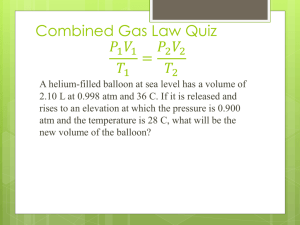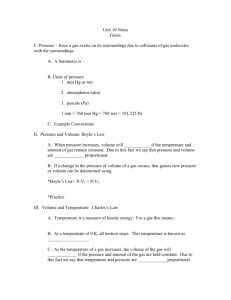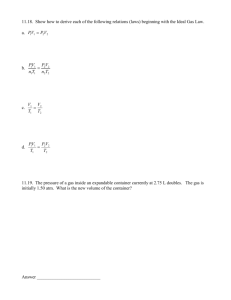Chemistry 112 Third Hour Exam Name:____________
advertisement
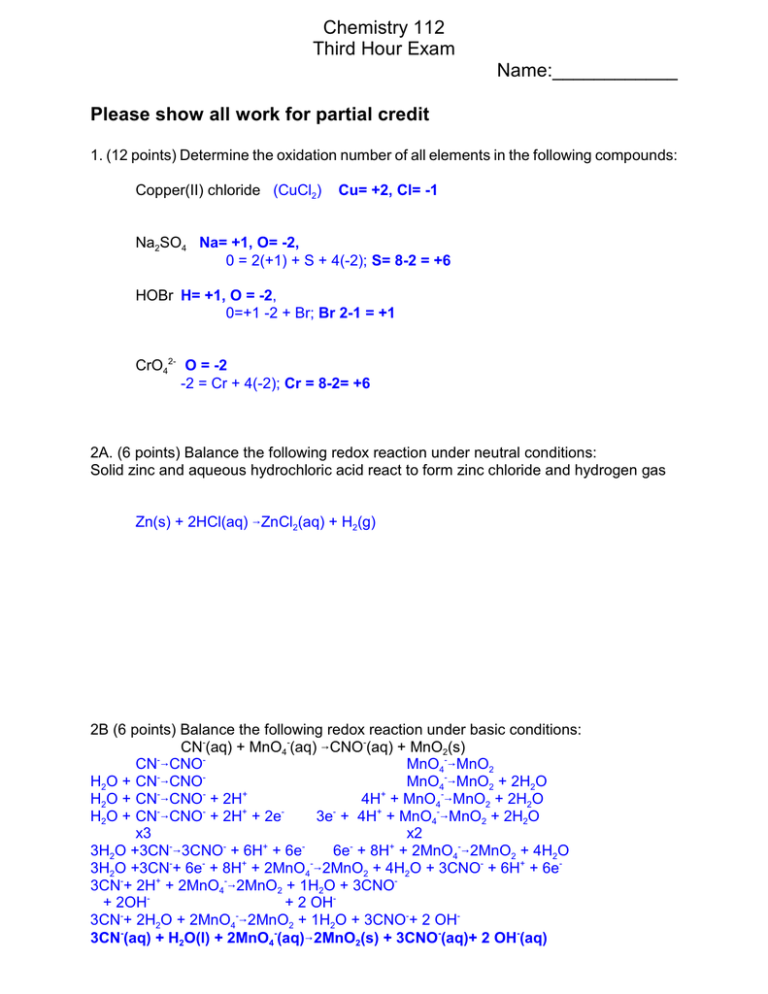
Chemistry 112 Third Hour Exam Name:____________ Please show all work for partial credit 1. (12 points) Determine the oxidation number of all elements in the following compounds: Copper(II) chloride (CuCl2) Cu= +2, Cl= -1 Na2SO4 Na= +1, O= -2, 0 = 2(+1) + S + 4(-2); S= 8-2 = +6 HOBr H= +1, O = -2, 0=+1 -2 + Br; Br 2-1 = +1 CrO42- O = -2 -2 = Cr + 4(-2); Cr = 8-2= +6 2A. (6 points) Balance the following redox reaction under neutral conditions: Solid zinc and aqueous hydrochloric acid react to form zinc chloride and hydrogen gas Zn(s) + 2HCl(aq) 6ZnCl2(aq) + H2(g) 2B (6 points) Balance the following redox reaction under basic conditions: CN-(aq) + MnO4-(aq) 6CNO-(aq) + MnO2(s) CN-6CNOMnO4-6MnO2 H2O + CN 6CNO MnO4-6MnO2 + 2H2O + + H2O + CN 6CNO + 2H 4H + MnO4-6MnO2 + 2H2O H2O + CN-6CNO- + 2H+ + 2e3e- + 4H+ + MnO4-6MnO2 + 2H2O x3 x2 3H2O +3CN-63CNO- + 6H+ + 6e6e- + 8H+ + 2MnO4-62MnO2 + 4H2O 3H2O +3CN-+ 6e- + 8H+ + 2MnO4-62MnO2 + 4H2O + 3CNO- + 6H+ + 6e3CN-+ 2H+ + 2MnO4-62MnO2 + 1H2O + 3CNO+ 2OH+ 2 OH3CN-+ 2H2O + 2MnO4-62MnO2 + 1H2O + 3CNO-+ 2 OH3CN-(aq) + H2O(l) + 2MnO4-(aq)62MnO2(s) + 3CNO-(aq)+ 2 OH-(aq) 2 3. (12 points) A diamond anvil is used by chemists and physicists to obtain pressures in excess of 360 GPa, roughly equivalent the pressure in the center of the earth. Express this pressure in Torr, Atm, and Lbs/in2 Torr Atm Lbs/in2 4. (13 points) Assume you have 1 1.0 L container of He gas at STP. What will happen to the specified properties of the gas under the following conditions. Acceptable answers are: No Change (NC); Increase (8); Decrease (9); or cannot be determined (NOT). Volume is increased to 2 l Average Kinetic E average velocity NC NC frequency of collisions Pressure 9 9 frequency of collisions Pressure Temp is decreased to 200K Average Kinetic E 9 Mole fraction of He NC 9 9 Half the molecules of the He are removed Non-ideality of Gas NC or NOT average velocity NC frequency of collisions 9 Pressure 9 3 5.) I have 5 grams of water (Molar mass 18.016g) and 5 grams of methanol (Molar mass 32.04g) In a closed container with a volume of 200 ml. I am going to heat the container to 200oC, so both liquids will be turned into gases. A. (4 points) What is the mole fraction of water in the container? Moles water = 5/18.016 = .278; moles methanol = 5/32.04 = .156 ÷=moles water/total moles = .278/(.278+.156) =.641 B. (4 points) What is the partial pressure of water in the container? Pressure as if there was only water, using ideal gas; PV=nRT P = nRT/V = .278(.08206)(200+273) / .2 liters = 53.9 atm C. (4 points) What is the total pressure in the container? Pressure using total moles of gas for n; PV=nRT P = nRT/V = (.278+ .156)(.08206)(200+273) / .2 liters = 84.2 atm 6. (13 points) Under what conditions of temperature and pressure will a gas act in a nonideal manner? Why? High pressure and moderate to low temperature. Under these conditions there are lots of gas molecules packed into a given volume, so the volume of the individual gas molecule becomes significant. Further, since the gas molecules are at a high concentration they can interact with each other and this changes their apparent pressure. To some degree these effects can be overcome at higher temperature where the higher T gives the individual gas molecules more kinetic energy, and this tends to alleviate these non-ideality effects 4 7. (12 points) What is the density of SF6 gas at STP at STP 1 mole of gas occupies 22.42 l SF6 has a molar mass of 32.07 + 6(19.00) = 146.02g so density is 146.02g/22.42R = 6.52g/l 8. (13 points) Define the following terms State Function A function or property of a system that depends only on the current state of the system, and not the path by which the state was achieved. Internal Energy Sum of the kinetic and potential energies of all the particles in a system. ÄE=q+w Potential Energy The energy that is stored in the position or composition of a system. Work Force acting over a distance. Work of a gas expanding is w =-PÄV Exothermic A process that releases heat energy. Thermodynamics The study of energy flow.

